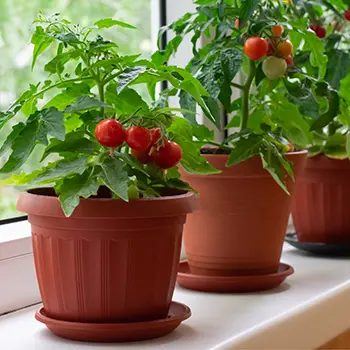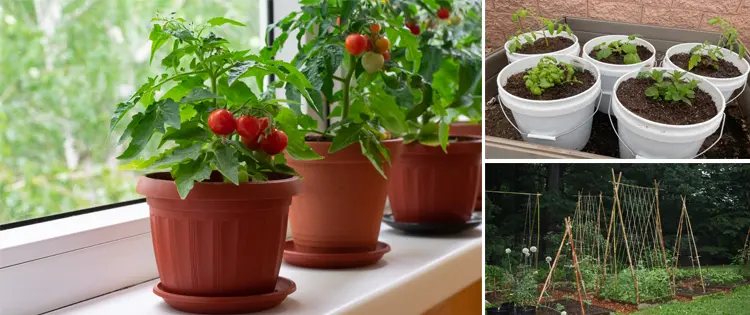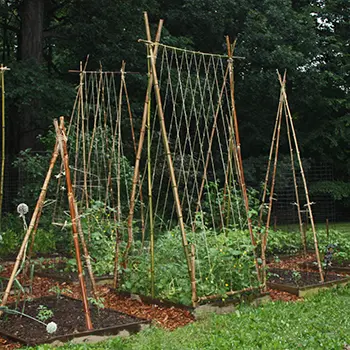We all dream of big, luscious gardens with huge plots of land and the ability to till it until our arms are ready to fall off. Unfortunately, that isn’t always the reality for even the most passionate gardeners. For this article, I’ll be focusing on only vegetables but do remember that you can grow almost anything even with extremely limited space. Let’s look at vegetables you can grow in small spaces!
Plant Picks
Any miniature vegetable is almost always a welcome sight in the tiny garden. We’re looking for varieties that grow easily in containers or square-foot-style gardens, which are the most common ways to get plenty of oomph out of your small spaces.
I suggest any variety of bush squash or cucumber, cherry and Roma tomatoes, miniature eggplants, all varieties of bush and runner beans, lentils, peas, and any other legume you can imagine. Potatoes, sweet potatoes, onions, and garlic all make amazing additions to the garden and are easy to find both in miniature and in types that are made for tiny gardens.
In fact, potatoes, sweet potatoes, onions, and garlic can all be planted in reusable grocery store bags if you simply poke a few holes through them. This allows you to hang the bags by their straps (if they are strong enough), fill them with soil, and up your capacity for plants. These also work well with tomatoes, peppers, eggplants; and basically anything else in the nightshade family.
Greens are easy picks for testing your small garden area and are often some of the cheapest seeds out there.
Some types of beefsteak and slicing tomatoes may be viable, though the plants might not fruit quite as much as they would in a larger garden.
What Not To Grow
Large, exploratory plants like melons and big squash (including pumpkins, though Jack-Be-Littles might work in a heavily contained environment). You’ll want to avoid tall plants that cannot be trellised, too, such as corn and brussels sprouts.
Unfortunately, this leaves out a lot of our favorite green plants. Broccoli, cauliflower, cabbage; all of these plants are usually so large and bulbous that you’d end up with maybe one head of each per pot or space. That’s pretty unacceptable when you get down to it, so, we can’t possibly recommend them. If you are using in-ground or in-bed square-foot gardening techniques, you might get away with putting these plants in but you’re probably going to bust out of your garden in doing so.
Related: 15 Gardening Mistakes You’re Making Right Now
I also can’t recommend long-term plants such as asparagus. These simply take too much time to mature and, even if buying crowns with years on them already, you’ll often find that they object to very small spaces or pots since they are used to settling into a place for good. Most perennials are poor choices for tight-space gardening since they will be disturbed when you place your annuals in next year, too.
The exception in this is container gardening. You can try to grow asparagus, rhubarb, and artichokes in larger containers, but keep in mind that they will likely need to come in for the winter in chillier climates.
Extremely hot full-sized peppers also should not be grown in small gardening areas. These plants may require some specialized fertilizer to get that nuclear-level heat and that will probably roll over into other planting areas when in a situation like this. That can ruin your cucumbers or bush zucchini very quickly.
Up Not Out
In an ideal small space garden, you work with your upward motion more than your outward growing motion. This means putting beans, peas, and anything else that will trellis up a trellis or working them to grow over other plants. It also means that plant stands, when available and appropriately sized, may allow you to have more room than you initially believe you do!
Ultimately, small space gardening is growing in multiple directions at once while making sure that your plants aren’t suffering. You may be manipulating their natural growth pattern, but it is worth it for them and for you. There is no greater accomplishment than managing to make a miniaturized, full-sized plant offer a bounty of vegetables that rival the full-sized plants in other areas of your garden (or from people that perhaps did a seed-sharing event with you).
If you are still struggling with thinking up rather than out, look at vertical gardening plans and see how you can put those into action on your own property or within your own small garden. These plans usually use tricks that have been successful around the world in Japan, South Korea, and the United States in professional growing areas, in homes, and even at theme parks such as Epcot at Walt Disney World.
A Few Common Mistakes
Perhaps the biggest common mistake that we see is accidentally getting the wrong variety of plants. You believe that you’ve gotten a bush cucumber and no; it’s a vine and a spindly type at that. You can return the seed packet or the bare roots plants, but why? You might still be able to work with this.
If you get the wrong sort of plant, treat it like a bonsai tree. We caution that you may not get quite as much from the plant in terms of fresh vegetables (things like green onions notwithstanding), but you’ll still get to experience the joy of growing things.
Another problem many people have is fertilizer rollover. This includes such problems as the example above. Even if you are careful with regard to where you put plants and try to put them with familial growing systems, you will simply need different food for different plants at times.
Again, working with a container garden essentially negates this issue. Each plant is within its own pot and most plants won’t drip enough fertilizer on others so as to cause scorching or other such problems. However, if you don’t have this ability or you simply do not want to do this, be aware that plastic runners in between plots may be a necessity to avoid scorching, burning, and otherwise ruining more sensitive plants.
Last but not least, we often see fast-growing greens strangling off more sensitive plants, such as young snap peas (which tend to be a little less bold in high-intensity gardening areas). The best thing to do in this case is to snip off your greens and enjoy a nice salad that evening with dinner. If you intend to use greens as barriers between different types of plants, which is common in this practice, we recommend aggressive pruning throughout the season.
You may also like:
DIY Corner Vegetable Storage Bin
How to Make Bark Bread from a Tree that Grows on Almost Every Street in America (Video)
50 Off the Grid Homesteading Tips and Tricks
Survival DIY Projects You Can Start on Your Property Right Now















Was not able to click to purchase today